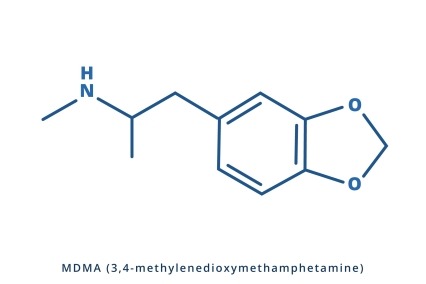
MDMA is a synthetic drug that acts as a stimulant and hallucinogen.15–17 It produces an energizing effect, distortions in time and perception, and enhanced enjoyment from sensory experiences. It has also been described as an entactogen—a drug that can increase self-awareness and empathy.1,2,18
Ecstasy is often used to refer to MDMA in the tablet or capsule form, which is the most common way people take the drug.17,19 Researchers have determined that many ecstasy tablets contain not only MDMA at different concentrations, but also a number of other drugs or drug combinations that can be harmful. Adulterants found in ecstasy tablets purchased on the street have included methamphetamine, the anesthetic ketamine, caffeine, the diet drug ephedrine,20 the over-the-counter cough suppressant dextromethorphan,21,22 heroin, phencyclidine (PCP), and cocaine.22
Molly—slang for “molecular”—refers to the crystalline powder form of MDMA, usually sold as powder or in capsules. Some people mistakenly believe that Molly does not contain contaminants often found in ecstasy. In fact, chemical analyses of drugs sold as Molly and seized by the U.S. Drug Enforcement Administration (DEA) have shown that they often contain other types of drugs and may not contain any MDMA.23 For example, epidemiologists from Washington state and Florida reported in 2013 that substances being sold as Molly were actually methylone, a synthetic stimulant commonly found in “bath salts.”24 In 2015, ethylone, a synthetic stimulant similar to methylone but with some differences in binding within the brain,25 replaced methylone as the main substance marketed as Molly.26 This underscores that people who take Molly often do not know what they are ingesting, and the substances sold as Molly may pose serious health risks.
When MDMA is taken in tablet or capsule form, a person begins feeling the effects 45 minutes later, on average. These effects peak 15 to 30 minutes after they are first felt and last an average of 3 hours,27 though side effects could be experienced up to days later.17,28 People typically take one to two tablets on each occasion,17,29,30 with each tablet generally containing between 50 and 150 milligrams of MDMA.31 People often take a second dose of the drug as the effects of the first dose begin to fade,32 increasing the risk of adverse side effects as doses combine.
MDMA seized in the United States is primarily synthesized in Canada and, to a lesser extent, the Netherlands. There are a small number of illegal MDMA labs operating in the United States.19